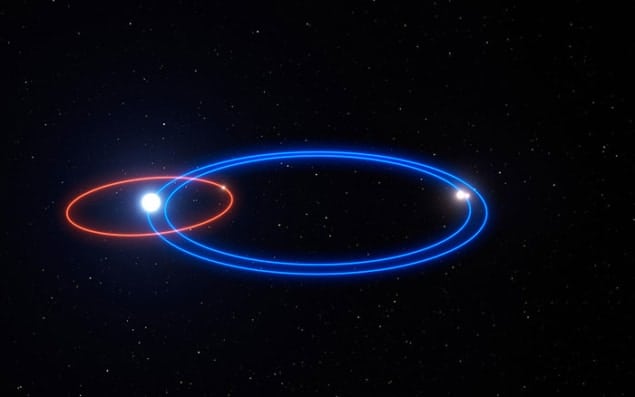
Imagine a world where three “suns” set one after another on some evenings, but at other times of the year there is always daylight. That is what it would be like on HD 131399Ab, which is a newly discovered planet four times as massive as Jupiter that orbits in a system of three stars. Spotted by an international team of astronomers using the SPHERE instrument on the Very Large Telescope in Chile, its very existence challenges current theories of how planetary systems form and evolve.
Astronomers have discovered more than 3000 planets orbiting stars other than the Sun, and the nearby universe is expected to harbour vast numbers of such extrasolar planets (exoplanets). So far, the exoplanets that we know about range from rocky bodies several times more massive than Earth to gas giants that dwarf Jupiter. HD 131399Ab is the first exoplanet to be discovered by the European Southern Observatory’s SPHERE instrument, which saw first light in 2014 and is designed to detect the extremely faint infrared light coming directly from distant exoplanets. Detecting light from an exoplanet is an extraordinarily difficult task, which is why most earlier discoveries of exoplanets were made by measuring their effect on light from their companion stars.
HD 131399Ab was spotted by Kevin Wagner and Daniel Apai of the University of Arizona, along with astronomers in the US, Germany and France. The team was astounded to find the planet in a very wide orbit around one of the stars (called A), with the two bodies separated by about 50 astronomical units (AU). This is a much larger orbit than any planet in the solar system – the furthest Neptune gets from the Sun is about 30 AU. The other two stars (B and C) are bound together in a binary system that is about 300 AU from A. Star A is the largest in the system, weighing in at about 1.8 solar masses, whereas B is slightly smaller than the Sun and C is about 0.6 solar masses. The system is about 300 light-years away from Earth.
Stable or unstable?
HD 131399Ab’s very wide orbit around A – which the team has calculated takes 550 Earth years to complete – came as a big surprise because astronomers had believed that such an orbit in a three-star system would be unstable. The team created a computer model of the system to try to understand why it holds together. “Our computer simulations showed that this type of orbit can be stable; but if you change things around just a little bit, it can become unstable very quickly,” explains Apai. The team also believes that the exoplanet may not have formed in its current orbit. One possibility is that HD 131399Ab once circled two stars but its orbit was disrupted by gravitational interactions with another unseen exoplanet or with the stars in the system.
Although the simulations do not provide a complete description of the motions of the exoplanet and its three stars, it gives enough information for Wagner to paint a vivid picture of one possible scenario. “For about half of the planet’s orbit, which lasts 550 Earth years, three stars are visible in the sky; the fainter two are always much closer together, and change in apparent separation from the brightest star throughout the year,” he says. “For much of the planet’s year, the stars appear close together, giving it a familiar night-side and day-side, with a unique triple sunset and sunrise each day.”
Midnight sun
Wagner explains, however, that this day–night cycle does not last for the entire HD 131399Ab year. “As the planet orbits and the stars grow further apart each day, they reach a point where the setting of one coincides with the rising of the other – at which point the planet is in near-constant daytime for about one-quarter of its orbit, or roughly 140 Earth years,” he says.
Despite the huge distance between HD 131399Ab and star A, the temperature on the surface of the planet is expected to be about 850 K (580 °C) despite being so far from its star. This could be related to the exoplanet’s youth – it is estimated to be just 16 million years old. In comparison, the Earth has been around for about 4.5 billion years.
“It is not clear how this planet ended up on its wide orbit in this extreme system, and we can’t say yet what this means for our broader understanding of the types of planetary systems out there, but it shows there is more variety out there than many would have deemed possible,” Wagner says. “What we do know is that planets in multi-star systems are much less explored, and potentially just as numerous as planets in single-star systems.”
The research is described in Science.



